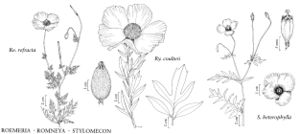Difference between revisions of "Romneya coulteri"
London J. Bot. 4: 75, plate 3. 1845.
EndemicIllustrated
Treatment appears in FNA Volume 3.
FNA>Volume Importer |
imported>Volume Importer |
||
| (One intermediate revision by the same user not shown) | |||
| Line 53: | Line 53: | ||
|publication year=1845 | |publication year=1845 | ||
|special status=Endemic;Illustrated | |special status=Endemic;Illustrated | ||
| − | |source xml=https:// | + | |source xml=https://bitbucket.org/aafc-mbb/fna-data-curation/src/2e0870ddd59836b60bcf96646a41e87ea5a5943a/coarse_grained_fna_xml/V3/V3_1096.xml |
|genus=Romneya | |genus=Romneya | ||
|species=Romneya coulteri | |species=Romneya coulteri | ||
Latest revision as of 21:45, 5 November 2020
Plants 10-25 dm. Leaves 5-20 cm. Flowers: calyx distinctly beaked at bud apex, glabrous; petals 6-10 cm. Capsules 3-4 cm. Seeds dark brown, papillose. 2n = 38.
Phenology: Flowering spring–summer (Apr–Aug).
Habitat: Dry washes, canyons
Elevation: less than 1200 m
Discussion
Romneya coulteri shares with Hibiscus lasiocarpos the distinction of having the largest flowers of any plant native to California.
Selected References
None.
Lower Taxa
None.

